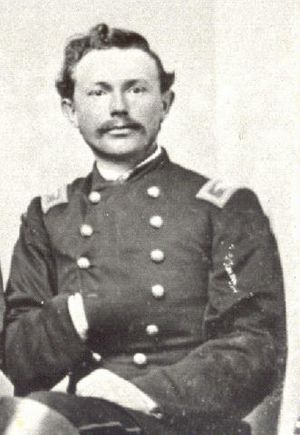Charles Garrison Harker facts for kids
Quick facts for kids
Charles G. Harker
|
|
|---|---|

Col. Charles G. Harker
ca. 1862 |
|
| Born | December 2, 1837 Swedesboro, New Jersey |
| Died | June 27, 1864 (aged 26) Kennesaw Mountain, Georgia |
| Place of burial |
Trinity Church Cemetery, Swedesboro, New Jersey
|
| Allegiance | United States of America Union |
| Service/ |
United States Army Union Army |
| Years of service | 1858–1864 |
| Rank | |
| Commands held | 65th Ohio Infantry 3rd Brigade, 2nd Division, IV Corps |
| Battles/wars | American Civil War |
| Other work | Career soldier |
Charles Garrison Harker (born December 2, 1837 – died June 27, 1864) was a brave leader in the Union Army during the American Civil War. He was a brigadier general, which is a high-ranking officer. Sadly, he died fighting in the Battle of Kennesaw Mountain in Georgia. A place called Fort Harker in Kansas was later named after him.
Contents
Early Life and Military Training
Charles Harker was born on December 2, 1837, in Swedesboro, New Jersey. When he was young, he worked in a store. A local politician, Nathan T. Stratton, helped him get into the United States Military Academy. This famous school in West Point, New York trains future army officers.
Harker graduated from West Point in 1858. He became a second lieutenant in the United States Army. His first jobs were at army posts in New York Harbor and in the Oregon and Washington areas.
Joining the Civil War
When the American Civil War began, Harker was sent to Ohio. His job was to help train new volunteer soldiers for the Union Army. He quickly moved up in rank. On May 14, 1861, he became a first lieutenant. Then, on October 24, 1861, he was promoted to captain.
Soon after, Harker became a colonel of the 65th Ohio Infantry regiment. This happened on November 11, 1861. A regiment is a large group of soldiers.
Key Battles and Promotions
Colonel Harker and his 65th Ohio Infantry fought in several important battles. In April 1862, they were part of the Battle of Shiloh. They also took part in the Siege of Corinth in Mississippi. Later that year, Harker led his troops in the Battle of Perryville in Kentucky.
Harker was highly praised for his actions at the Battle of Stones River. This battle took place at the end of 1862. He showed great leadership while commanding his brigade, which is a smaller group of soldiers within a larger army.
In 1863, Harker continued to lead his brigade. He again impressed his commanders during the Battle of Chickamauga in Georgia. His strong defense against the Confederate army was noticed. Because of his excellent service, he was promoted to brigadier general on September 20, 1863.
General Harker and his men also fought in the battles around Chattanooga. They helped attack Missionary Ridge. After that, they went to help another general, Ambrose E. Burnside, during the Siege of Knoxville.
Final Battle and Legacy
In the middle of 1864, the Atlanta Campaign began. This was a major effort by the Union army to capture Atlanta. General Harker led a brigade under General Oliver O. Howard. On May 7, Harker successfully defended Rocky Face Ridge against strong Confederate attacks.
However, the war was dangerous. On June 27, 1864, General William T. Sherman's Union army tried to attack Confederate forts on Kennesaw Mountain. During this difficult attack, General Harker was shot and badly wounded. He died from his injuries.
His body was sent back to his hometown of Swedesboro, New Jersey. He was buried in the Trinity Episcopal Church Cemetery. General Charles G. Harker is remembered as a brave officer who served his country during a difficult time.

